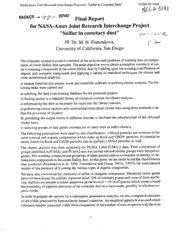
NASA Technical Reports Server (NTRS) 19980185827: Sulfur in Cometary Dust PDF
Preview NASA Technical Reports Server (NTRS) 19980185827: Sulfur in Cometary Dust
NASA-Ames Joint Research Interchange Proposal: "Sulfur in Cometary Dust" UCSD 97-5502 NASMCR...--. _ 7-" 207467 Final Report for NASA-Ames Joint Research Interchange Project "Sulfur in cometary dust" PI: Dr. M. N. Fomenkova, University of California, San Diego The computer-intensive project consisted of the analysis and synthesis of existing data on compo- sition of comet Halley dust particles. The main objective was to obtain a complete inventory of sul- fur containing compounds in the comet Halley dust by building upon the existing classification of organic and inorganic compounds and applying a variety of statistical techniques for cluster and cross-correlational analyses. A student hired for this project wrote and tested the software to perform cluster analysis. The fol- lowing tasks were carried out: a) selecting the data from existing database for the proposed project; b) finding access to a standard library of statistical routines for cluster analysis; c) reformatting the data as necessary for input into the library routines; e) performing cluster analysis and constructing hierarchical cluster trees using three methods to de- fine the proximity of clusters; d) presenting the output results in different formats to facilitate the interpretation of the obtained cluster trees; e) selecting groups of data points common for all three trees as stable clusters. The following assumptions were used for this classification: i) Mixed particles are mixtures of the same mineral and organic components which make up Rock and CHON particles; ii) correlation trends found for Rock and CHON particles can be applied to Mixed particles as well. The cluster analysis was done separately for PUMA-1 and PUMA-2 data. Then comparison of groups identified in PUMA1 and PUMA2 sets was carried out and similar groups were merged to- gether. The resulting compositional groupings of mass spectra yield us a complete inventory of car- bonaceous compounds in the comet Halley dust. At this point, we are ready to use the classification thus produced (Fomenkova et al. 1994, Fomenkova and Chang 1997a, 1997b) for correlational studies of the presence of S among the various types of organic compounds. We have also considered the chemistry of sulfur in inorganic compounds. Elemental sulfur grains have not been found. Fe-sulfides represent about 10% of cometary grains and some of them are Ni- rich. Sulfates are present in minor quantities (at the level of- 1% of all grains) which points toward the possibility of aqueous alteration of the cometary dust on a microscale, possibly in a hydrocryo- genic mode. In order to prepare the spectra for a subsequent quantitative analysis, we also completed estimates of ion yields produced by hypervelocity-impact ionization. An empirical approach was used which estimates relative ionization yields from comparison of the number of ions in spectra with the total NASA-Ames Joint Research Interchange Proposal: "Sulfur in Cometary Dust" UCSD 97-5502 mass of dust particles. We found that in mass-spectra obtained in the wide-energy-window mode (so called 'short' spectra) the weight ratio of the sum of ions of elements with high electronegativity to the sum of ions of rock-forming elements (with low electronegativity) is 1.7 +_0.2 for all mass ranges. On the other hand, in mass-spectra obtained in the narrow-energy- window mode (so called 'long' spectra) this ratio increases from 0.4 to 1.2 when the mass of dust particles increases from 5 x 10-17 g to 5 x 10-12 g. Therefore, we introduced empirical mass- dependent coefficients which compensate the difference between 'short' and 'long' spectra. Applying the proper corrections to the spectra will allow us to calculate how the bulk abundance of S in comet Halley dust is distributed between organic and inorganic compounds. These data can be compared with the data on S chemistry in carbonaceous chondrites (inorganic, sulforganic, kerogens), and in the ISM. Finally, we obtained some spectra containing the molecular lines of OCS for comet Hyakutake us- ing the near-IR spectrometer CSHELL at NASA Infrared Telescope Facility. The analysis of these data is in progress. PUBLICATIONS Fomenkova, M. Organic component of cometary dust (1997). In From Satrdust to Planetesimals (eds. Y. Pendleton & A. Tielens), pp. 415-421 (ASP Conference Series 122). Fomenkova, M. and S. Chang (1997a). Carbonaceous components of organic/inorganic assem- blages in comet Halley dust. Meteoritics & Planetary Sci. 32, A44. Fomenkova, M. and S. Chang (1997b). Analysis of the carbonaceous component of comet Hal- ley dust. VI Symposium on Chemical Evolution and the Origin and Evolution of Life (abstr.)
